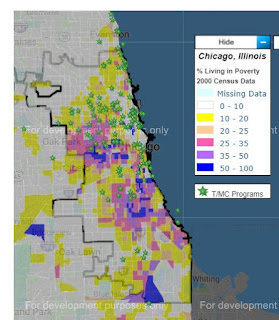A few days later I created a graphic with a set of maps, by WBEZ, and by the Tutor/Mentor Connection (T/MC), which I created in 1993 and still lead today.
Chicago is a huge city, thus drawing people from affluent areas into poverty neighborhoods to be part of organized volunteer-based tutor/mentor programs becomes more difficult, as the distances grow. Yet the rich transportation system in Chicago provides access routes that many could use to reach places in neighborhoods where they might connect with kids during the after work (5pm to 8pm hours).
About a week ago I started seeing Tweets from The Bridgespan Group about a report titled "Four Pathways to Greater Giving", which focused on the philanthropy of the ultra-wealthy.
For the ultra-wealthy, spending down 50% of wealth in 20 years requires an annual payout rate of more than 11%. Yet on average, America’s wealthiest donate just 1.2% of their assets to charity each year. Learn more.— The Bridgespan Group (@BridgespanGroup) December 3, 2018
For the ultra-wealthy, spending down 50% of wealth in 20 years requires an annual payout rate of more than 11%. Yet on average, America’s wealthiest donate just 1.2% of their assets to charity each year. Learn more.— The Bridgespan Group (@BridgespanGroup) December 3, 2018
I am reading the report now, and highlighting key passages, using Hypothes.is. You're welcome to join me.
Imagine if super wealthy donors adopted high poverty sections of Chicago and its suburbs, with long-term involvement and investment. That's been my vision for many years. I used the graphic below in a 2014 article, and again last year, when two billionaires were asking for political donations to support their campaign for Governor of Illinois.
If you use the "drive by poverty" map, you see expressways running through each of the poverty zones of Chicago. While these are physical transportation routes, they can also be virtual guides, to places on the Internet where volunteers, donors, youth development program staff and leaders, researchers and others can talk about the needs of youth and families and the way well-organized, volunteer-based tutor/mentor programs expand social capital and support systems and offer a path out of poverty, while also engaging more people in discussions of the other related problems that also need to be addressed.
In the Bridgespan Group report, one challenge raised was finding trusted intermediaries who could channel large donations to a network of smaller organizations. In the graphic below, I show the role of a Tutor/Mentor Connection, connecting people who could help, including wealthy people, with places where kids and families need help, and organized youth development, tutor and mentor programs in those places.
While I point to a map of Chicago on this graphic, that map could be any major city in the world, and the intermediary could be an organization coached by myself to apply Tutor/Mentor Connection strategies, using tools that I've been trying to develop with limited and inconsistent resources for more than two decades.
The beauty of the Internet is that anyone can spend as much, or as little, time as they want digging into the information that's available.
Thus, I invite those who can help to browse through my past articles, read PDF reports like this, showing what I've been trying to build, then as you build your understanding, begin to think of ways you might help me re-build the T/MC for Chicago, but make it a useful tool for any city.
Or, spend time in this planning Wiki, to see what I've been trying to do, what needs help and rebuilding, and what opportunities still need to be developed.
It's the Oscars this weekend, so read this article, which I wrote about a "do over" following the 2017 Oscars, when the wrong movie was announced as "Best Picture". Think of ways an ultra wealthy family might adopt, and own, this re-build, as their own long term commitment to closing the wealth and opportunity gaps in America and the world.
I've written several more "do over" articles since then, which you can find here.
In the short term, a contribution in the five figures or less might have a great impact on helping me continue to bring attention to these ideas. Visit this page if you're interested.




























